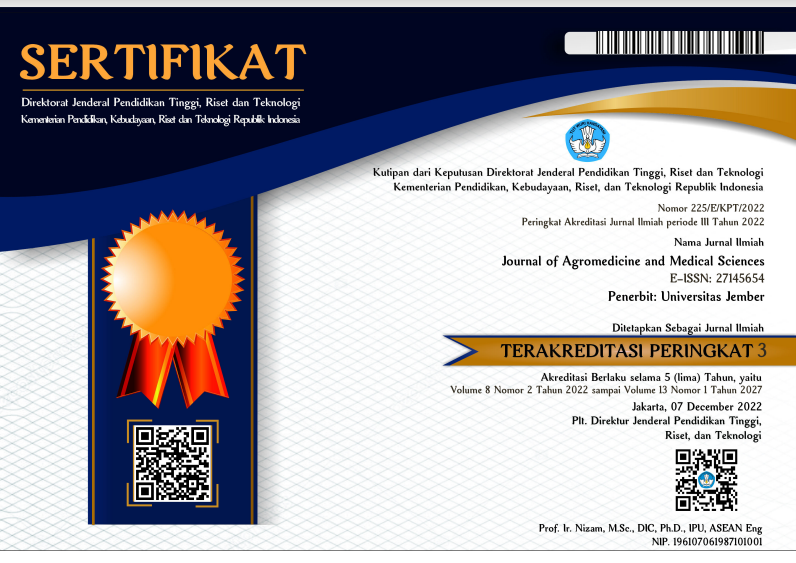Correlation between the Use of Shared Goods with Pediculosis Capitis among Students in Pondok Pesantren Subulussalam Palembang
DOI:
https://doi.org/10.19184/ams.v8i2.29113Abstract
Pediculosis capitis is a parasitic infection caused by the parasite Pediculus humanus var. capitis, which commonly found in densely crowded areas such as boarding schools. It is possible to contract pediculosis capitis by coming into direct or indirect contact with sufferers' hair. The goal of this study was to assess the prevalence of pediculosis capitis in students at Pondok Pesantren Subulussalam Palembang, as well as the association between the use of shared goods and the occurrence of pediculosis capitis. This study is a cross-sectional observational analytic study including 116 students who live permanently in Pondok Pesantren Subulussalam Palembang. A questionnaire was used to collect data, as well as direct observation of hair samples. The Chi-Square test, Fisher's exact test, and logistic regression were used to examine the results. The findings revealed that 35.3% of people had pediculosis capitis, and that there was a significant association between the use of mattresses (p=0.007), combs (p=0.024), and shared veils (p=0.006) and the occurrence of pediculosis capitis. The use of combs (p=0.018) and shared veils (p=0.001) were the most influential variables on the occurrence of pediculosis capitis, according to the results of the logistic regression test. The spread of pediculosis capitis disease is predicted to be reduced and prevented with improved personal hygiene, environment sanitation, and treatment.
Keywords: Pediculosis capitis, boarding schools, Subulussalam, shared goods
Downloads
References
Arsinta, D., Anwar, C., & Ramdja, M. (2019). Association of Sharing Materials with Pediculosis Capitis in Students of Pondok Pesantren Tahfidzil Qur’an Yayasan Tijarotal Lan Tabur Palembang. Majalah Kedokteran Sriwijaya, 51(3). https://doi.org/10.36706/MKS.V51I3.9208
Azim, F., & Andrini, N. (2018). Perbandingan Angka Kejadian Pedikulosis Kapitis Antara Anak Laki-Laki Dengan Anak Perempuan Di Pondok Pesantren Al-Kautsar Al-Akbar Medan. Jurnal Ibnu Sina Biomedika, 2(1), 72–79. https://doi.org/10.30596/ISB.V2I1.1903
Azni, S. M. (2013). Prevalence of Head Lice at the Primary Schools in Damghan. Zahedan Journal of Research in Medical Sciences, 16(11), 47–49. https://brieflands.com/articles/zjrms-1168.html
Bartosik, K., Buczek, A., Zając, Z., & Kulisz, J. (2015). Head pediculosis in schoolchildren in the eastern region of the European Union. Annals of Agricultural and Environmental Medicine : AAEM, 22(4), 599–603. https://doi.org/10.5604/12321966.1185760
Hardiyanti, N. I., Kurniawan, B., & Mutiara, H. (2019). Hubungan Personal Hygiene terhadap Kejadian Pediculosis Capitis pada Santriwati di Pesantren Jabal An-Nur Al-Islami Kecamatan Teluk Betung Barat Bandar Lampung. Jurnal Agromedicine, 6(1), 38–45. https://juke.kedokteran.unila.ac.id/index.php/agro/article/view/2248
López-Valencia, D., Medina-Ortega, Ã., & Vásquez-Arteaga, L. R. (2017). Prevalence and variables associated with pediculosis capitis in kindergarten children from Popayán, Colombia. Revista de La Facultad de Medicina, 65(3), 425–428. https://doi.org/10.15446/REVFACMED.V65N3.58812
Lukman, N., Armiyanti, Y., & Agustina, D. (2018). The Correlation of Risk Factors to the incidence of Pediculosis capitis on Students in Pondok Pesantren Miftahul Ulum, Jember. Journal of Agromedicine and Medical Sciences, 4(2), 102–109. https://doi.org/10.19184/AMS.V4I2.6488
Madke, B., & Khopkar, U. (2012). Pediculosis capitis: an update. Indian Journal of Dermatology, Venereology and Leprology, 78(4), 429–438. https://doi.org/10.4103/0378-6323.98072
Maryanti, E., Maryanti, E., Lesmana, S. D., & Novira, M. (2018). Hubungan Faktor Risiko dengan Infestasi Pediculus humanus capitis pada Anak Panti Asuhan di Kota Pekanbaru. Jurnal Kesehatan Melayu, 1(2), 73–80. https://doi.org/10.26891/jkm.v1i2.2018.73-80
Munusamy, H., Elsa, E., Murhandarwati, H., & Umniyati, S. R. (2014). The Relationship Between The Prevalence of Head Lice Infestation with Hygiene and Knowledge Among The Rural School Children In Yogyakarta. Tropical Medicine Journal, 1(2). https://doi.org/10.22146/TMJ.4573
Nadira, Sulistyaningsih, & Rachmawati. (2020). Hubungan Antara Personal Hygiene dan Kepadatan Hunian Dengan Kejadian Pedikulosis kapitis Di Desa Sukogiri Jember. Journal of Agromedicine and Medical Sciences, 6(3), 161–167. https://repository.unej.ac.id/handle/123456789/90132
Nejati, J., Keyhani, A., Tavakoli Kareshk, A., Mahmoudvand, H., Saghafipour, A., Khoraminasab, M., Tavakoli Oliaee, R., & Mousavi, S. M. (2018). Prevalence and Risk Factors of Pediculosis in Primary School Children in South West of Iran. Iranian Journal of Public Health, 47(12), 1923. /pmc/articles/PMC6379608/
Rangkuti, A. F., & Nurcahyati, F. I. (2020). Analisis Tingkat Pengetahuan dan Personal Hygiene Dengan Kejadian Pediculosis Capitis di Pesantren Binaul Ummah Kabupaten Bantul. Dunia Keperawatan: Jurnal Keperawatan Dan Kesehatan, 8(3), 479. https://doi.org/10.20527/dk.v8i3.8088
Rassami, W., & Soonwera, M. (2012). Epidemiology of pediculosis capitis among schoolchildren in the eastern area of Bangkok, Thailand. Asian Pacific Journal of Tropical Biomedicine, 2(11), 901–904. https://doi.org/10.1016/S2221-1691(12)60250-0
Saghafipour, A., Nejati, J., Zahraei-Ramazani, A., Vatandoost, H., Mozaffari, E., & Rezaei, F. (2017). Prevalence and Risk Factors Associated with Head Louse (Pediculus humanus capitis) in Central Iran. International Journal of Pediatrics, 5(7), 5245–5254. https://doi.org/10.22038/IJP.2017.23413.1967
Sanei-Dehkordi, A., Soleimani-Ahmadi, M., Zare, M., Madani, A., & Jamshidzadeh, A. (2017). Head Lice Infestation (Pediculosis) and Associated Factors among Primary School Girls in Sirik County, Southern Iran. International Journal of Pediatrics, 5(12), 6301–6309. https://doi.org/10.22038/IJP.2017.25917.2206
Setyoasih, A., & Suryani, D. (2016). Hubungan antara Pengetahuan, Personal Hygiene, dan Infestasi Pediculus humanus var. capitis pada Santriwati Muhammadiyah Boarding School Prambanan Sleman Yogyakarta. Jurnal Kedokteran Dan Kesehatan, 12(1), 116–213. https://doi.org/10.24853/JKK.12.2.190-201
Sindayo, T., Molla, T., Assefa, A., Tilahun, B., & Haven, H. (2020). Prevalence of Scabies and Associated Factors among Primary School Children in Raya Alamata District, Tigray, Ethiopia, 2017/2018. Journal of Infectious Diseases and Epidemiology, 6(5). https://doi.org/10.23937/2474-3658/1510154
Suparto. (2015). Persyaratan Lingkungan Hunian Sehat. Majalah Ilmiah Pawiyatan, 22(1), 87–94. https://adoc.pub/persyaratan-lingkungan-hunian-sehat.html
Suwandi, J. F., & Sari, D. (2017). Dampak Infestasasi Pedikulosis Kapitis Terhadap Anak Usia Sekolah. Majority, 6(1), 24–29. https://juke.kedokteran.unila.ac.id/index.php/majority/article/view/926
Tohit, N. F. M., Rampal, L., & Mun-Sann, L. (2017). Prevalence and predictors of pediculosis capitis among primary school children in Hulu Langat, Selangor. Medical Journal of Malaysia, 72(1), 12–17. https://pubmed.ncbi.nlm.nih.gov/28255134/
Veracx, A., & Raoult, D. (2012). Biology and genetics of human head and body lice. Trends in Parasitology, 28(12), 563–571. https://doi.org/10.1016/J.PT.2012.09.003
Wolf, L., Eertmans, F., Wolf, D., Rossel, B., & Adriaens, E. (2016). Efficacy and Safety of a Mineral Oil-Based Head Lice Shampoo: A Randomized, Controlled, Investigator-Blinded, Comparative Study. PloS One, 11(6). https://doi.org/10.1371/JOURNAL.PONE.0156853
Yunida dkk, S., yang Berhubungan, F.-F., Yunida, S., & Rachmawati, K. (2017). Faktor-Faktor Yang Berhubungan Dengan Kejadian Pediculosis Capitis Di SMP Darul Hijrah Putri Martapura: Case Control Study. Dunia Keperawatan: Jurnal Keperawatan Dan Kesehatan, 4(2), 124–132. https://doi.org/10.20527/DK.V4I2.2516






















